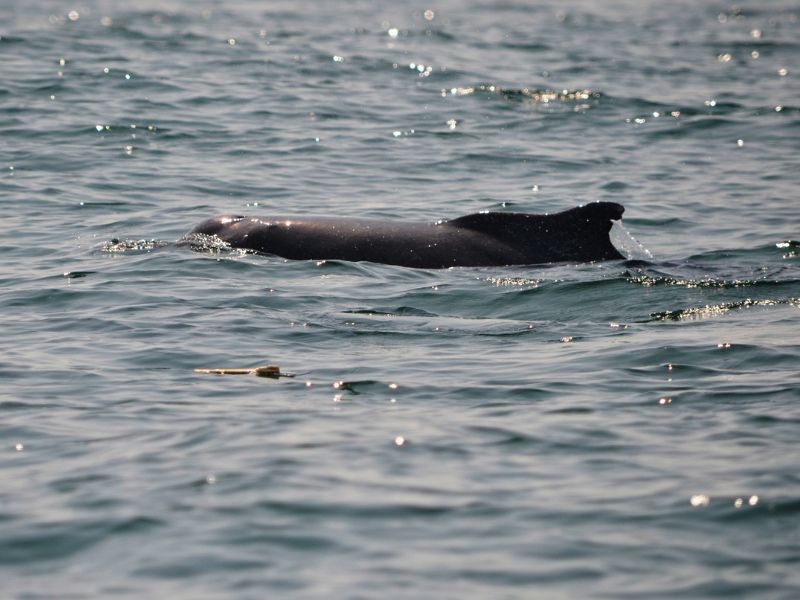
Dolphins are the ocean’s sweethearts. They’re playful and intelligent and kind, but also wild. They have a funny way of coming when you call them… and going away when you don’t.
Dolphins are magical creatures, and we’re excited to bring you the opportunity to experience them first-hand.
We believe that everyone should have the chance to meet dolphins and learn about their intelligence, beauty and grace. And now we can make that dream a reality.
Our tours take you out on a boat where you can see dolphins in their natural environment. Enjoy a calm and enjoyable dolphin safari to locate wild dolphins in the Arabian Sea. You could witness one or two different varieties of dolphins or porpoises. The Indo-Pacific Humpback Dolphin is one, while the Finless Porpoises are another. Both are frequently seen when Dolphin Watching in Goa.
Rest assured a dolphin encounter is an unforgettable experience.
Dolphins play an important role in the health of our oceans, and visiting one on a boat is a great way to learn more about these incredible animals.
It’s crucial to remember that these creatures roam long distances in search of food, so there’s no telling where they’ll be at any one moment. Our extensive expertise and knowledge, on the other hand, will give you the highest opportunity of spotting them. It’s also worth noting that they are incredibly sensitive and clever animals, so don’t throw anything in the water or yell.
These are a species of large oceanic dolphin, found in tropical and temperate waters around the world’s oceans. They are critically endangered due to the effects of commercial fishing. The humpback dolphin is one of the most widely recognized types of dolphin, due to its distinctive appearance with a large ‘hump’ on its back. There are five species of humpback dolphin: Sousa sousa, Sousa chinensis, Sousa plumbea, Sousa teuszii and Sousa chinensis. The humpback dolphin is named for the prominent ‘hump’ on its back which is formed by the dorsal fin and can be up to 2 m (6 ft) tall. The name ‘humpback’ comes from the whale’s characteristic shape when viewed from above, which resembles that of a seahorse or an elephant seal.
While larger and more common, the Indo-Pacific Finless Porpoise is a lesser known species of porpoise. Found in the Indian Ocean from Antarctica to Southeast Asia, these small porpoises are known for their lack of a dorsal fin, which distinguishes them from other porpoises. They are also smaller and slimmer than the Northern Hemisphere’s common porpoise species, which has long been assumed to be the only porpoise species in the world. The Indo-Pacific Finless Porpoise, to give it its proper name, is the other giant marine animal that lives in the seas near Goa.
During our dolphin safari, you get to spot the friendly Indo – Pacific Humpback dolphins and shy Finless Porpoises.
Dolphins are magical creatures, and you’ll be able to experience them first-hand with our tours.
We offer fun-filled dolphin watching in Goa, take a look at our website to find out more about the tours we offer.
Come join us on a dolphin tour and enjoy a day filled with this magical creature!
Give us a call to know more about the dolphin-watching tours we have in Goa!

Find answers to common questions below. If you need further assistance, feel free to contact us.
Because dolphins are free to move in their natural home, the water, there is a 1% chance you will not see one. Sometimes they are very close to the boat; sometimes a little further away. If you think positive chances are much better.
If you miss your chance to see Goa’s famous hump-back dolphins, you will receive a 50% discount on your next trip because you will have seen a lot of sights (including the Portuguese Jail, Aguada Fort, The Billionaire’s Palace, Asia’s first light house, and Goa’s beautiful coastline) despite not seeing any dolphins.
Camera with additional storage space, head-cap or visor, sunscreen, binoculars, and a windsheeter / jacket are all must-haves. Though none of them are required to schedule a vacation, possessing them will help you enjoy it more.
Every trip is different. Dolphins will be viewed up close sometimes, and other times they will be at a distance. It is illegal to touch or feed wild dolphins.
No, they are not. However, you are free to carry some with you if you’d like.